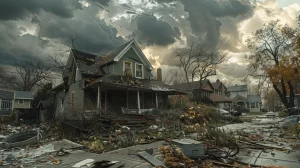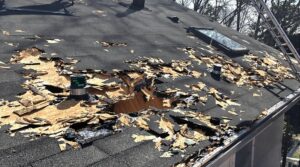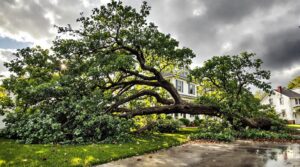Storm damage claims require systematic documentation and prompt communication with insurance providers. Homeowners must thoroughly photograph damages, maintain detailed records, and understand their policy's coverage limits and exclusions. Licensed public adjusters can help navigate complex claims, potentially increasing settlements by 30-50%. Essential steps include emergency repairs, obtaining multiple contractor estimates, and organizing all communications. A methodical approach to the claims process guarantees ideal compensation for property restoration.
Key Takeaways
- Document all storm damage thoroughly with photos, videos, and written descriptions before making temporary repairs to prevent further damage.
- Contact your insurance company immediately to report damage, obtain a claim number, and keep detailed records of all communications.
- Review your policy's specific deductibles, coverage limits, and exclusions for storm-related damages, especially regarding wind and water damage.
- Consider hiring a public adjuster for complex claims, as they can help maximize settlements and navigate the claims process effectively.
- Obtain multiple repair estimates from licensed contractors and ensure they align with the insurance adjuster's scope of work.
Does Homeowners Insurance Cover Storm Damage?
Insurance policies for storm damage often include named storm deductibles, which typically represent a percentage of the home's insured value rather than a fixed amount.
Homeowners must carefully examine their policy documents to understand specific coverages and limitations regarding different types of storm events, including wind, hail, and water damage.
Critical policy review areas include coverage limits, exclusions, special endorsements, and the distinction between standard deductibles versus those that apply specifically to named storms.
Working with public adjusters can help homeowners maximize their storm damage claim settlements by 30-50% compared to handling claims independently.
Named Storm Deductibles
Many coastal homeowners face a specialized policy provision known as named storm deductibles, which differ substantially from standard insurance deductibles. When filing a claim for storm damage insurance, these deductibles typically range from 1% to 5% of the insured property's value, activated only when damage occurs from storms officially designated by the National Weather Service.
| Aspect | Details |
|---|---|
| Deductible Range | 1-5% of property value |
| Activation | Named storms only |
| Coverage Type | Wind and hail damage |
| Additional Considerations | Separate flood coverage needed |
Understanding named storm insurance coverage is vital for homeowners in coastal regions. While some insurance companies don't impose these specialized deductibles, those that do require careful documentation of damage and proper claim filing procedures. Homeowners should review their insurance policy thoroughly to comprehend their specific coverage terms and financial obligations during storm damage claims. Working with licensed public adjusters can significantly increase settlement amounts for complex storm damage claims while ensuring proper documentation and valuation.
Reviewing Your Home Insurance Policy Coverage
Understanding what storm damage coverage a homeowners insurance policy includes requires careful examination of specific provisions and exclusions. Standard policies typically provide protection for various storm-related incidents, but coverage limits and deductibles vary considerably among insurers.
| Coverage Type | Typical Policy Status |
|---|---|
| Wind Damage | Generally Covered |
| Hail Damage | Generally Covered |
| Fallen Trees | Usually Covered |
| Flood Damage | Separate Policy Required |
| Hurricane Damage | Special Deductibles May Apply |
When filing a claim, homeowners must document all storm-related damages thoroughly through photos and detailed descriptions. Insurance providers distinguish between replacement cost and actual cash value when determining compensation. While most policies cover wind and hail damage, specific exclusions may apply, particularly for flood-related incidents. Understanding these distinctions is essential for steering through the insurance claims process effectively and ensuring appropriate coverage for potential storm damage. Additional living expenses coverage helps pay for temporary housing if storm damage makes your home uninhabitable during repairs.
Documenting The Storm Damage Accurately
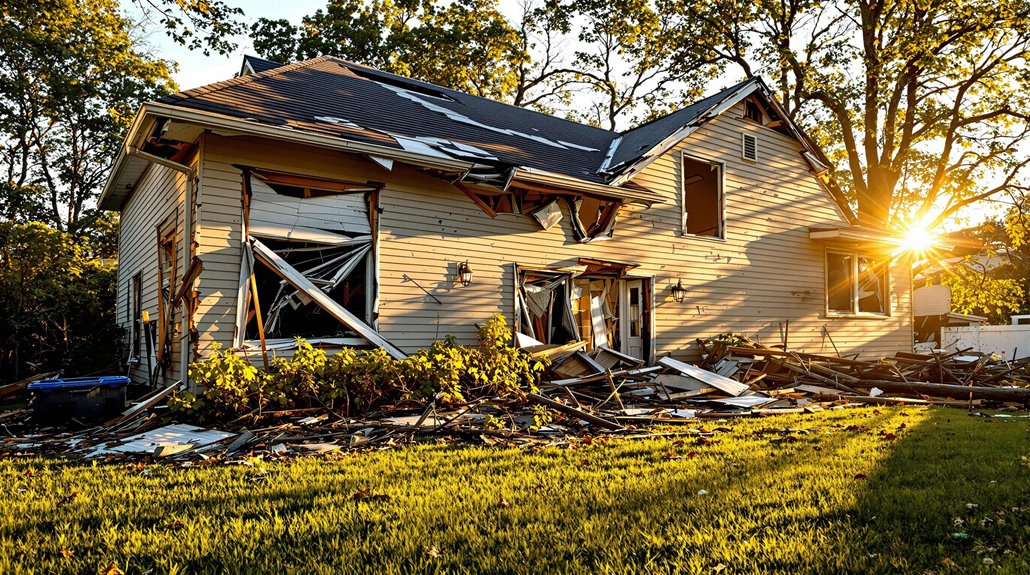
Accurate documentation of storm damage requires systematic photographic evidence and detailed written descriptions to support insurance claims effectively. Property owners should capture high-resolution images from multiple angles, ensuring each damaged area is clearly visible and identifiable for assessment purposes. Thorough notes accompanying the photographs should specify the location, extent, and nature of damage while maintaining a structured inventory of affected items. Working with public insurance adjusters can help maximize settlement amounts for extensive storm damage claims.
| Documentation Element | Required Details |
|---|---|
| Photographs | Multiple angles, clear lighting, date stamps |
| Written Descriptions | Location, type, extent of damage |
| Inventory List | Item details, estimated values, purchase dates |
| Supporting Documents | Receipts, prior condition photos, repair estimates |
| Timeline Records | Damage occurrence, temporary repairs, communications |
Detailed Damage Photographs
Clear visual documentation serves as the cornerstone of a successful storm damage insurance claim. When photographing damaged areas, homeowners should capture multiple angles to provide complete evidence of the extent of the damage. Both wide-angle shots displaying overall property condition and detailed close-ups of specific damages are essential for insurance adjusters to assess the claim accurately.
- Document all damaged belongings with photos showing their pre-storm condition alongside current damage.
- Record time-stamped photographs and video footage while describing damage in real-time.
- Capture detailed photographs of structural issues, including broken windows, roof damage, and water intrusion.
This systematic approach to photographing storm damage creates a thorough visual record that supports the insurance claim process and helps guarantee proper coverage for all damaged items. Working with a public insurance adjuster can help maximize your settlement by ensuring all documentation meets professional standards.
Comprehensive Description Notes
While photographs provide visual evidence of storm damage, maintaining detailed written descriptions serves as an equally essential component of the documentation process.
Following National Association of Insurance Commissioners guidelines, homeowners must document all storm damage systematically to guarantee accurate reimbursement during the insurance claim process.
Creating organized records of communications with the insurance company helps streamline claims processing and prevents potential disputes.
- Create a detailed list of damaged items, including make, model, purchase date, and estimated value
- Record specific measurements of damaged areas, including dimensions of affected walls, roofing, or structural components
- Note environmental conditions during the storm event, such as wind speed, precipitation amounts, and time of damage occurrence
These thorough notes supplement visual evidence and strengthen the overall documentation package for claims assessment.
Public insurance adjusters can provide valuable expertise in documenting and maximizing settlements for storm-related claims.
Communicating With Your Insurance Company
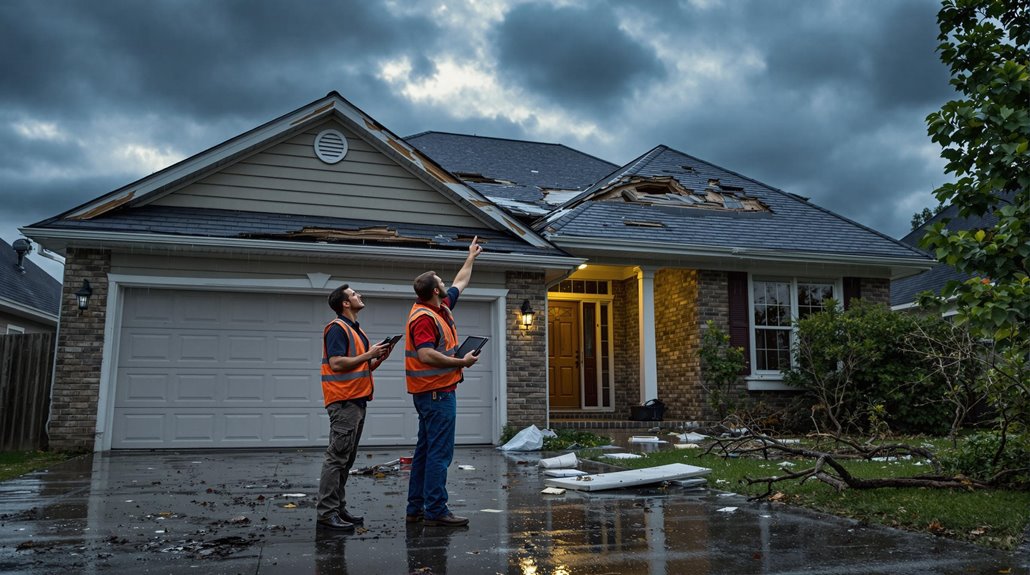
Effectively communicating with insurance companies forms the cornerstone of successful storm damage claims processing. When filing your claim, policyholders must initiate contact promptly to obtain a claim number and begin the documentation process.
Insurance companies require detailed documentation of property damage, including detailed photographs and itemized lists of affected items.
Throughout the claims process, maintaining extensive records of all communications with the insurer is essential. This includes logging dates, times, and specific details of every interaction.
When the claims adjuster visits the property, homeowners should be present to provide additional context and guarantee accurate damage assessment. Clear, consistent communication helps facilitate timely responses and resolution of questions or concerns.
Storm damage insurance claims require a systematic approach to correspondence. Policyholders should maintain copies of all submitted materials, follow up regularly on claim status, and promptly respond to any requests for additional information from their insurance company.
Effective communication and collaboration between homeowners, contractors, and insurance providers can significantly enhance the likelihood of claim approval and fair compensation.
Initiating The Storm Damage Insurance Claim Process
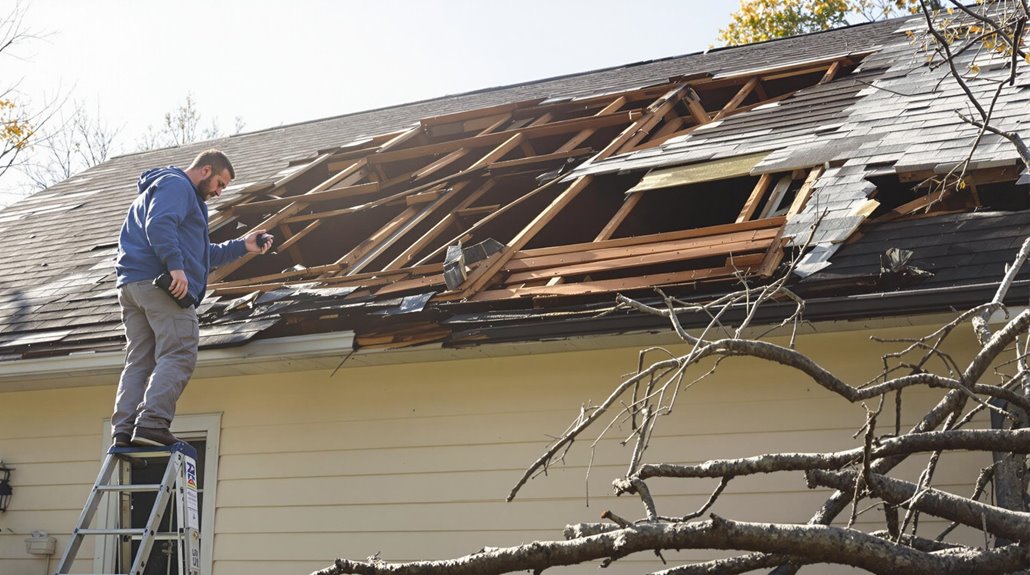
When initiating a storm damage insurance claim, property owners must first thoroughly review their insurance policy to understand coverage parameters and exclusions. Documentation of all storm-related damage through extensive photographs, videos, and written descriptions establishes a solid foundation for the claim's success. The engagement of a public adjuster, followed by prompt notification to the insurance provider, can greatly enhance the probability of a favorable claim resolution. Understanding liability and medical payments coverage within your policy helps protect against potential injury claims during the repair process.
| Step | Action Required |
|---|---|
| 1 | Review policy details and coverage limits |
| 2 | Photograph and document all visible damage |
| 3 | Contact public adjuster for assessment |
| 4 | File claim with insurance provider |
Review Your Policy
The initial step in managing a storm damage insurance claim requires homeowners to conduct a thorough review of their policy documentation. This critical examination helps identify specific coverage for storm damage, including limitations and exclusions related to wind, hail, and flooding events.
Homeowners must carefully assess their deductibles for storm-related claims, which often vary based on the type of damage incurred. Standard homeowners insurance typically encompasses wind and hail damage coverage, but flooding requires a separate flood insurance policy.
To guarantee proper understanding of coverage terms, policyholders should contact their insurance provider for clarification of complex policy language before initiating the claims process. This proactive approach helps prevent misunderstandings about coverage scope and facilitates smoother processing of homeowners insurance claims.
Understanding whether your policy provides actual cash value or replacement cost coverage significantly impacts potential claim settlements for storm damage repairs.
Document All Damage
Proper documentation of storm damage serves as the cornerstone of a successful insurance claim process. Homeowners must capture thorough photographs and videos of all affected areas, ensuring complete coverage of structural and property damage. This visual evidence supports the insurance claims process and validates the extent of losses.
Creating a detailed inventory list strengthens the claim by cataloging damaged items with descriptions, estimated values, and available receipts. The National Association of Insurance Commissioners recommends preserving damaged items when feasible for adjuster inspection.
Upon documenting the damage, homeowners should promptly contact their insurance company to obtain a claim number and initiate the formal process. Maintaining thorough records of all communications, submitted documentation, and correspondence with the insurer establishes a clear timeline and facilitates efficient claim resolution. Working with public adjusters during the documentation phase can increase claim settlements by up to 30-50% compared to handling the process alone.
Contact A Public Adjuster
Engaging a public adjuster during the storm damage claims process provides homeowners with professional representation and expertise in steering through complex insurance settlements.
These licensed adjusters specialize in evaluating property damage, interpreting policy language, and negotiating with insurance companies to secure a fair settlement.
When hiring a public adjuster, homeowners should consider their claims experience and reputation, as fees typically range from 5% to 20% of the final settlement.
Public adjusters strengthen claims by conducting thorough assessments, compiling extensive documentation, and managing communications with insurance carriers.
They document storm damage through detailed photographs, inventory lists, and written reports, ensuring all damage is properly identified and valued.
While the service involves a cost, their expertise often results in higher settlements and a more efficient claims process, particularly for extensive storm damage cases.
Contact Insurance Provider
Initiating contact with an insurance provider immediately after storm damage is critical for maximizing claim potential and guaranteeing timely compensation.
Policyholders must report damage promptly, providing specific details about the storm event and resulting destruction. During this initial communication, obtaining a claim number is essential for tracking and future correspondence.
To efficiently process your claim, insurance providers require thorough documentation. This includes a detailed home inventory of damaged items, complete with descriptions and available receipts.
Homeowners should maintain meticulous records of all interactions with their insurance provider, including dates, representative names, and conversation summaries. This systematic approach to the claims process helps guarantee accurate claim assessment and facilitates smoother communication between all parties involved in resolving the storm damage claim.
Meeting With Insurance Adjusters
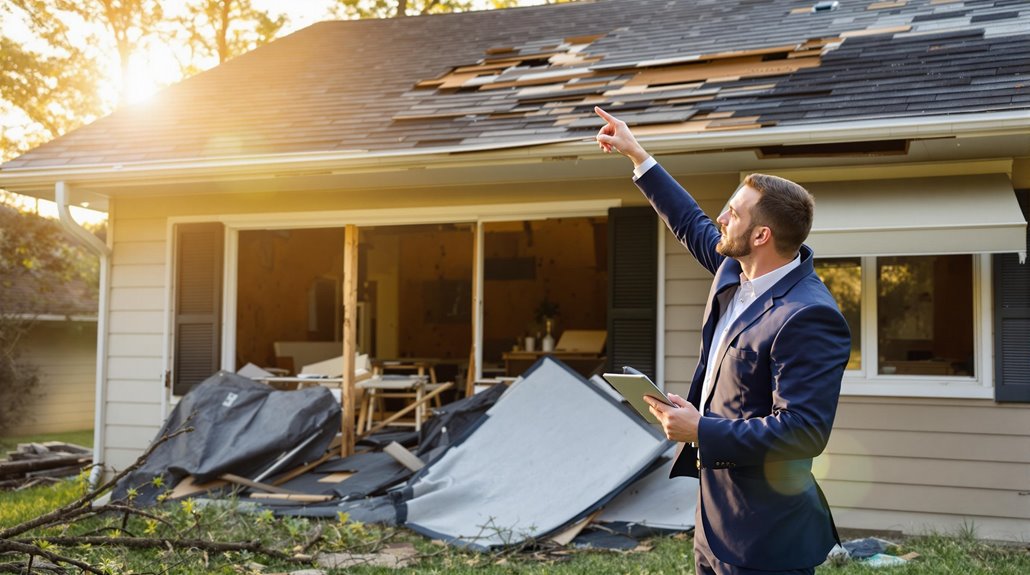
Meeting with insurance adjusters requires thorough preparation of documentation, including photographs, receipts, and detailed damage descriptions to substantiate the claim.
During the assessment process, adjusters evaluate the extent of storm damage, verify policy coverage, and calculate repair costs based on current market values. Successful claim settlements often depend on effective communication with adjusters and may benefit from the expertise of public adjusters who can advocate for fair compensation.
- Documentation checklist: policy documents, timeline of events, photographic evidence, repair estimates, and receipts for emergency repairs
- Assessment components: structural evaluation, interior damage inspection, exterior impact analysis, and cost calculations
- Settlement considerations: coverage limits, deductible amounts, depreciation factors, and replacement cost provisions
Preparing Essential Documentation
When preparing for an insurance adjuster's assessment, homeowners must assemble detailed documentation that clearly demonstrates the extent of storm-related damages. A exhaustive inventory list should include model numbers, purchase receipts, and detailed descriptions of affected items. Documenting all temporary repairs and maintaining associated receipts guarantees potential reimbursement during the claims process.
| Documentation Type | Purpose | Impact on Claim |
|---|---|---|
| Photos/Videos | Visual Evidence | Establishes damage extent |
| Receipts | Cost Verification | Supports reimbursement |
| Inventory List | Item Documentation | Validates loss value |
| Policy Documents | Coverage Clarity | Confirms claim eligibility |
Understanding coverage limits and deductibles before meeting with the insurance adjuster allows homeowners to effectively present their claim and negotiate appropriate compensation based on clear evidence of storm damage.
Understanding The Assessment Process
The assessment phase represents a critical juncture in the insurance claims process, where adjusters conduct detailed property inspections to evaluate storm-related damages.
During this phase, insurance adjusters meticulously examine the property, documenting visible destruction while referencing the homeowners policy guidelines to determine coverage applicability.
Property owners should actively participate in the assessment, directing attention to specific areas of storm damage and providing supplementary documentation, including photographs and expense records.
The adjuster utilizes standardized evaluation protocols to assess the damage and determine whether repairs or replacement are warranted.
Following the inspection, they compile a thorough report detailing their findings, which serves as the foundation for calculating the final settlement amount.
Clear communication between homeowners and adjusters throughout this process guarantees accurate damage documentation and facilitates fair claim resolution.
Negotiating Claim Settlements
Successful claim settlements often hinge on effective negotiations with insurance adjusters during the post-assessment phase. Homeowners can strengthen their position by maintaining thorough documentation of storm damage and being present during the adjuster's inspection to highlight all affected areas.
During negotiations, policyholders should reference their homeowners policy to articulate their understanding of coverage terms, particularly regarding replacement cost versus actual cash value.
Maintaining detailed records of all communications and presenting organized documentation, including photographs and repair estimates, substantiates the claim's value.
If disagreements arise over the settlement amount, homeowners may consider engaging a public adjuster who can leverage professional expertise to negotiate higher compensation.
This third-party advocate can particularly benefit complex claims where significant disparities exist between the adjuster's assessment and the homeowner's documented losses.
How Public Adjusters Help
Professional public adjusters serve as valuable intermediaries during meetings with insurance company adjusters, offering expertise that can greatly impact claim outcomes.
These licensed professionals advocate for policyholders throughout the claims process, meticulously documenting storm damage and ensuring thorough coverage assessment.
Public adjusters leverage their deep understanding of insurance policies to streamline negotiations and secure appropriate payouts. Their expertise enables them to identify often-overlooked damages and present compelling evidence to insurance companies.
While charging between 5% and 20% of the settlement, their involvement typically results in a smoother claims experience and potentially higher compensation.
Their specialized knowledge of local regulations and policy interpretations proves particularly beneficial when resolving complex claims or disputes, allowing homeowners to focus on recovery while ensuring their interests remain protected.
Executing Temporary Repairs & Keeping Receipts
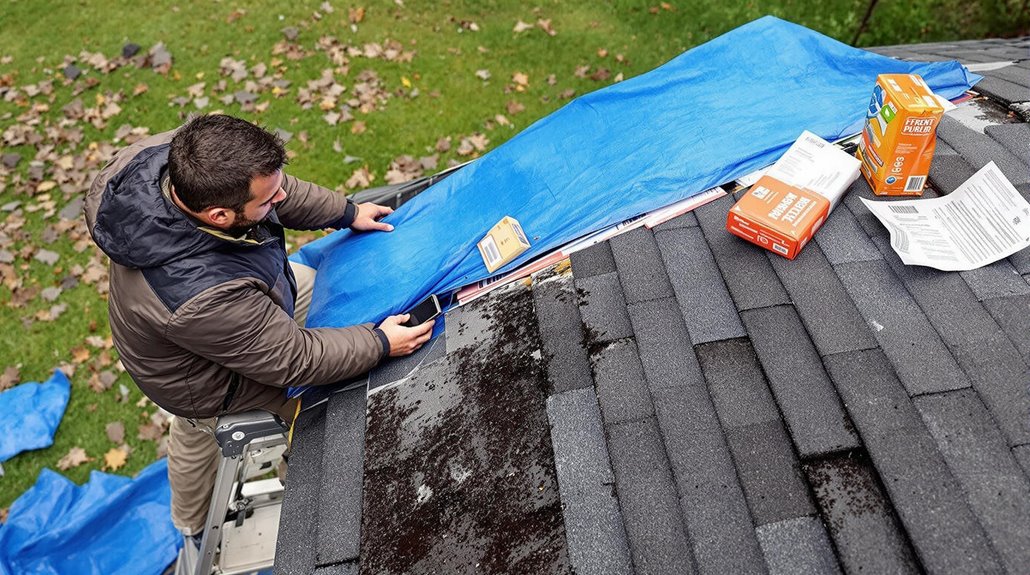
Protecting your home from further storm damage requires immediate action through strategic temporary repairs, while maintaining thorough documentation of all associated costs. Homeowners must prioritize emergency repairs such as covering broken windows and patching roof leaks, while systematically documenting damage through photographs and detailed notes.
| Action Item | Documentation Required | Purpose |
|---|---|---|
| Cover Windows | Photos + Receipts | Prevent Water Entry |
| Patch Roof | Photos + Receipts | Stop Leaks |
| Secure Doors | Photos + Receipts | Maintain Security |
| Remove Debris | Photos + Receipts | Prevent Additional Damage |
| Dry Affected Areas | Photos + Receipts | Mitigate Mold Risk |
Before initiating permanent repairs, homeowners should await the insurance adjuster's assessment. Each temporary repair requires photographic evidence showing both the damage and the emergency solution implemented. These records, combined with organized receipts for materials and services, create a thorough documentation package that supports the claims process and facilitates potential reimbursement from the insurance provider.
Understanding Coverage, Exclusions, And Deductibles
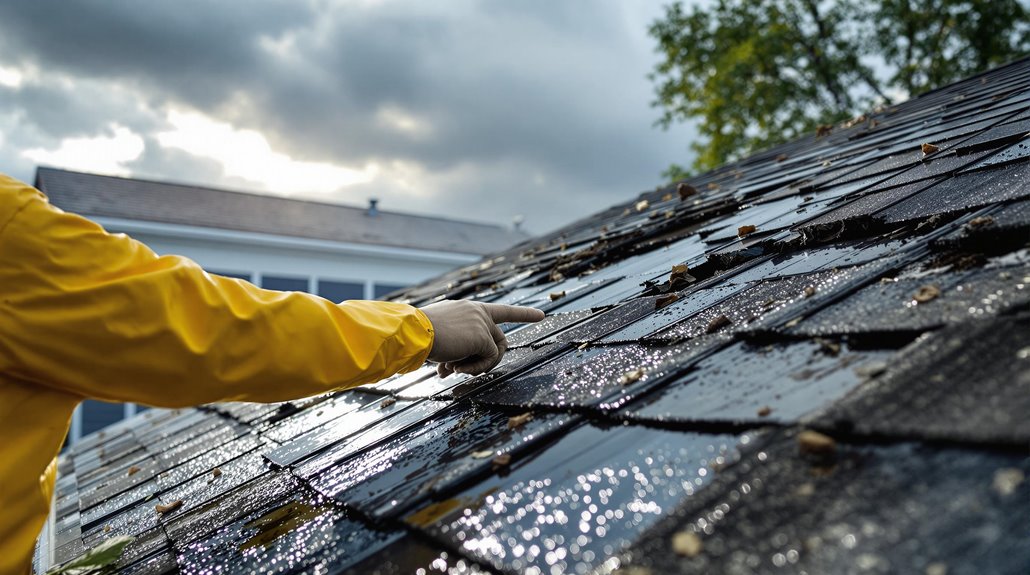
Understanding the specific terms of homeowners insurance coverage requires careful examination of policy documents to identify coverage limits, exclusions, and deductible structures. Insurance providers establish distinct parameters for storm-related damages, often implementing separate deductibles for different types of weather events and excluding certain perils like flood damage from standard coverage. Homeowners must analyze their policy's sub-limits, which may cap reimbursement amounts for specific repair categories, while also considering supplemental coverage options for excluded perils.
| Coverage Type | Typical Inclusions | Common Exclusions |
|---|---|---|
| Wind Damage | Roof damage, broken windows, structural impacts | Gradual deterioration |
| Water Damage | Burst pipes, rain entry from wind damage | Ground water, flooding |
| Tree Damage | Fallen trees on structures, removal costs | Dead tree removal, routine maintenance |
| Personal Property | Storm-damaged belongings inside home | Items in detached structures |
Policy Coverage Explanation
Most homeowners' insurance policies provide specific coverage for storm-related damages, but the extent and limitations of this coverage require careful examination.
Standard policy coverage typically addresses wind, hail, and fallen tree damage, while specifically excluding flood-related incidents. Understanding the deductible structure and coverage types is essential for effective claims processing.
Key policy components include:
- Replacement cost vs. actual cash value determination, affecting reimbursement amounts for damaged property
- Storm surge insurance and flood insurance requirements, particularly in high-risk zones where standard coverage proves insufficient
- Specific deductible variations for different types of storm damage, with windstorm claims often carrying higher thresholds
Reviewing these elements before filing a claim guarantees homeowners understand their coverage limitations and financial responsibilities during the claims process.
Common Exclusion Details
When reviewing storm damage insurance policies, homeowners must navigate a complex landscape of coverage exclusions and deductible variations that greatly impact their claims potential. Understanding common exclusion details is critical before the claims process begins, particularly in high-risk zones where specific limitations apply.
| Coverage Area | Key Exclusions |
|---|---|
| Water Damage | Flood damage requires separate policy |
| Wind Impact | Hurricane-specific restrictions apply |
| Maintenance | Neglect-related damage not covered |
| Deductibles | Varying amounts by damage type |
| Policy Limits | Sub-limits on specific damage types |
Insurance policy documentation typically excludes certain types of water damage, particularly flooding, which requires additional coverage. Homeowners insurance policies may also impose strict limitations in storm-prone regions, while damage resulting from poor maintenance remains consistently excluded. Understanding these nuances becomes essential before an adjuster arrives to assess damage claims.
Deductible Impact Analysis
Insurance deductibles represent a crucial factor in storm damage claims, directly affecting both the financial outcomes and decision-making processes for homeowners.
Understanding the deductible structure is essential for effective financial recovery planning, as these out-of-pocket expenses must be met before home insurance coverage activates. Policy limitations often include varying deductible levels based on specific perils, with separate thresholds for windstorm damage, hail, and other weather events.
Homeowners should carefully evaluate their policy's exclusions, particularly regarding flooding, which typically requires separate coverage.
The claim process necessitates a thorough cost-benefit analysis, comparing potential damage costs against applicable deductibles. In regions susceptible to severe weather, higher deductibles for specific storm damage scenarios may greatly impact the viability of filing an insurance claim.
Flood Damage Clarification
A significant number of property owners face substantial financial risks due to misconceptions about flood damage coverage in their standard homeowners insurance policies. Standard policies explicitly exclude water damage resulting from natural flooding, requiring a separate flood insurance policy for thorough protection.
The National Flood Insurance Program (NFIP), administered by FEMA, provides specific coverage limits and guidelines distinct from typical homeowners insurance.
Understanding financial responsibilities is vital during the storm damage claims process, as flood insurance deductibles often differ from standard policy deductibles.
Property owners must recognize that water damage from heavy rainfall may not qualify for coverage under their homeowners insurance due to insurance exclusions.
To guarantee adequate protection, homeowners should carefully review their policies and consider supplemental flood coverage through NFIP or private insurers.
Special Coverage Considerations
Understanding the intricacies of special coverage considerations requires homeowners to scrutinize their insurance policies' specific terms, limitations, and exclusions. Standard homeowners policies typically define specific parameters for storm-related claims, with distinct coverage limitations and deductibles for various types of damage.
| Coverage Type | Key Considerations |
|---|---|
| Wind Damage | Standard coverage with specific deductibles |
| Flood Damage | Requires separate policy; excluded from standard coverage |
| Hurricane Protection | May have higher deductibles in coastal regions |
| Loss of Use Coverage | Temporary relocation expenses during repairs |
When filing a storm damage insurance claim, homeowners must demonstrate adherence to maintenance obligations, as neglected upkeep can void coverage. Insurance pay for storm damage varies based on policy sub-limits, which may cap reimbursement for specific structural elements or personal property items.
Evaluating Repair Estimates
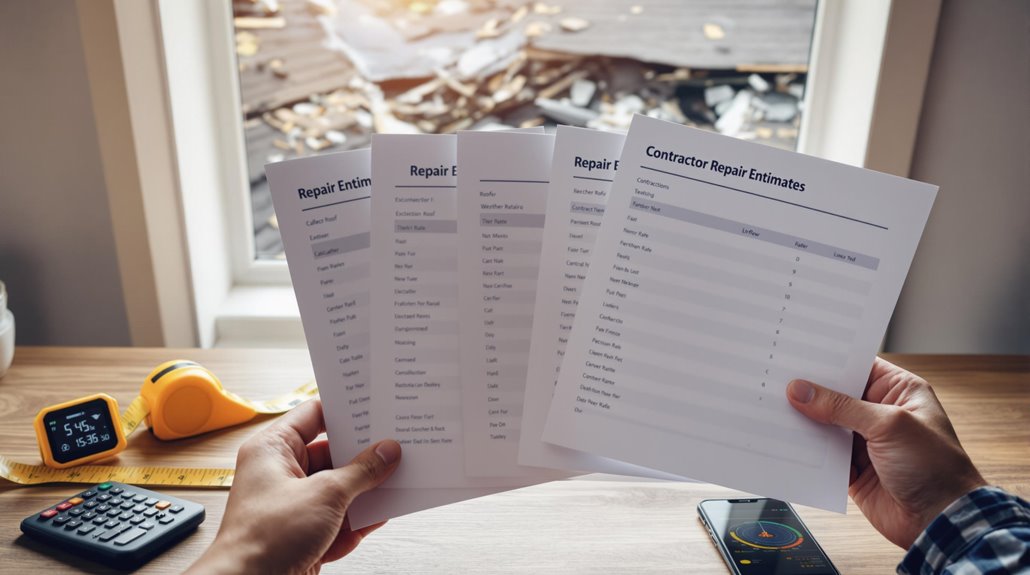
Once storm damage has been assessed, homeowners must carefully evaluate multiple repair estimates to guarantee they receive fair pricing and quality workmanship for their insurance claim. Licensed contractors should provide detailed breakdowns that align with the insurance adjuster's scope of work, enabling accurate comparisons and thorough coverage verification.
| Evaluation Criteria | Key Considerations |
|---|---|
| Cost Breakdown | Materials and labor itemization |
| Scope Alignment | Match with adjuster assessment |
| Quality Indicators | Contractor licensing and references |
| Timeline Details | Project duration and milestones |
When reviewing estimates, homeowners should be wary of markedly lower bids that might indicate substandard materials or services. Documentation of all repair estimates is essential for claims processing, and any discrepancies should be promptly communicated to the insurance adjuster. This systematic approach helps guarantee that the final approved repairs meet both quality standards and insurance coverage requirements.
Negotiating The Settlement Offer
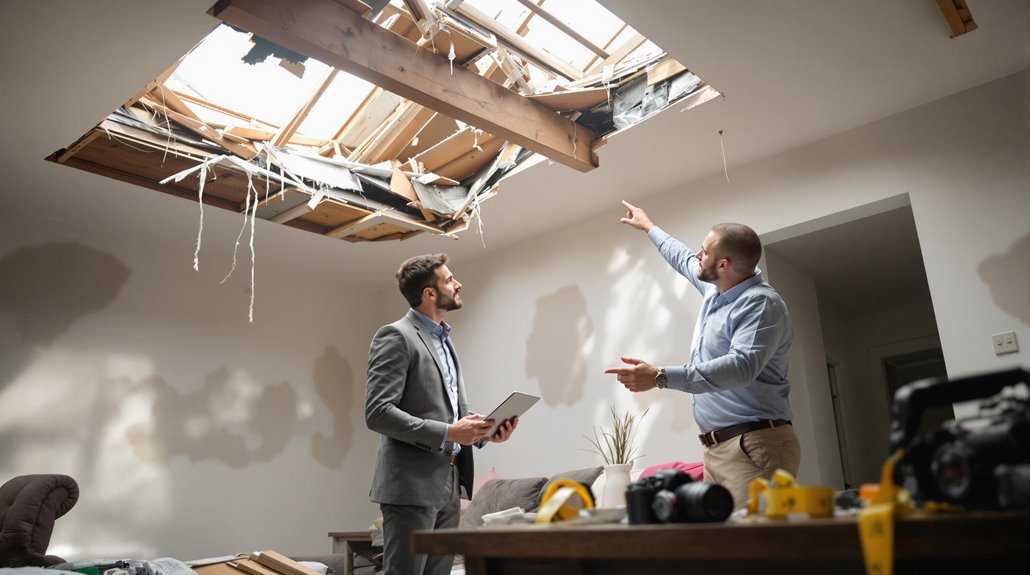
Homeowners facing storm damage claims can approach settlement negotiations either independently or with professional representation through a public adjuster.
Working without a public adjuster requires extensive documentation of damages, thorough understanding of policy terms, and direct communication with the insurance company's adjuster to justify the desired settlement amount.
Alternatively, engaging a public adjuster provides expert advocacy and industry knowledge, though their services typically cost between 5% and 20% of the final settlement.
This decision is dependent on claim complexity and the policyholder's negotiation expertise.
Negotiating With A Public Adjuster
Successful negotiation with a public adjuster requires strategic preparation and clear documentation of storm-related damages.
When engaging these professionals, who typically charge between 5% and 20% of the claim amount, policyholders should compile thorough damage documentation, including detailed photographs, repair estimates, and itemized inventories. This thorough approach strengthens the negotiating position and enables public adjusters to leverage their expertise in insurance policy interpretation.
Studies indicate that policyholders who utilize public adjusters often secure larger payouts compared to those handling claims independently.
To maximize settlement outcomes, clear communication of expectations and damage specifics is essential throughout the negotiation process. The public adjuster's specialized knowledge allows them to advocate effectively for settlement amounts that accurately reflect both visible damage and underlying repair costs.
Negotiating Without A Public Adjuster
Mastering direct negotiations with insurance companies requires a methodical approach to settlement discussions.
Homeowners must meticulously document storm damages through extensive photos, detailed lists, and relevant receipts to build a compelling case. Understanding policy coverage terms, deductibles, and exclusions strengthens negotiating positions during claim discussions.
When the insurance adjuster presents an initial offer, homeowners should maintain assertive yet professional communication while addressing any discrepancies.
Obtaining independent repair estimates from licensed contractors provides significant leverage for negotiating fair compensation.
If settlement offers remain insufficient, policyholders should persistently escalate concerns through proper channels within the insurance company, supported by thorough documentation of all interactions.
This systematic approach enhances the likelihood of securing appropriate compensation without public adjuster assistance.
Finalizing Repairs & Following Up
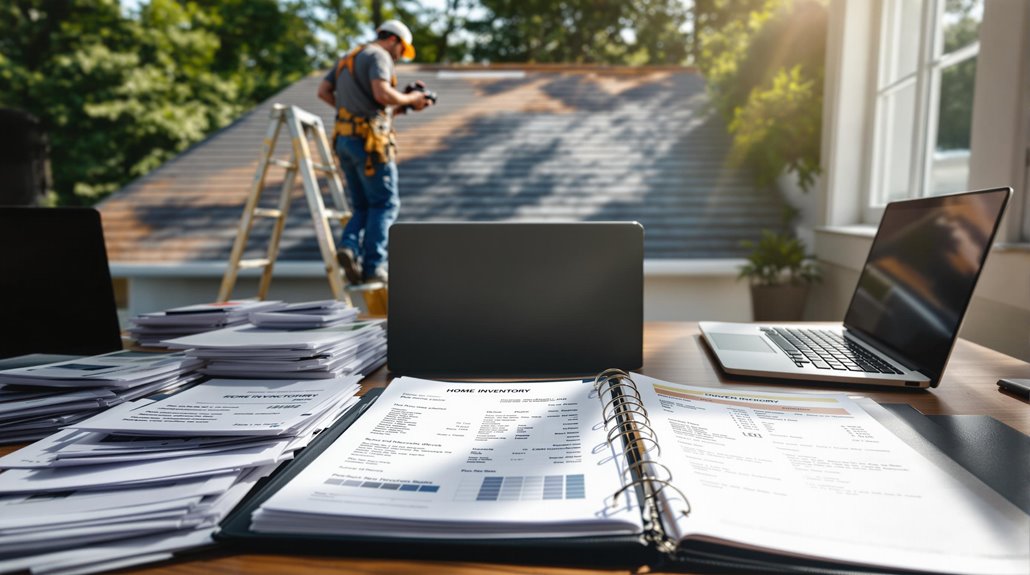
Completing storm damage repairs marks a vital shift point that requires meticulous documentation and structured follow-up procedures. Homeowners must maintain thorough records of all documented receipts and communication with contractors and their insurance provider throughout the repair process.
Important steps in finalizing repairs include verifying compliance with local building codes and obtaining necessary documentation to support future claims. Property owners should systematically photograph completed work and compile detailed repair documentation before submitting it to their insurance adjuster.
Following submission, maintaining consistent communication regarding reimbursement timelines proves essential for claim resolution.
Post-repair procedures should include updating the home inventory to reflect new installations or improvements made during the restoration process. This documentation serves as vital reference material for subsequent storm damage claims and guarantees accurate coverage assessment.
Regular follow-up with the insurance adjuster helps confirm proper processing of all submitted materials and facilitates timely reimbursement completion.
Frequently Asked Questions
What Not to Say to a Homeowners Insurance Adjuster?
Homeowners should avoid admitting fault, offering settlement amounts, discussing unrelated damage, using emotional language, or making vague damage descriptions when speaking with insurance adjusters during claims processes.
Will Home Insurance Cover Damage From a Storm?
Standard homeowners insurance typically covers storm-related damage from wind, hail, and fallen trees, excluding flood damage. Coverage specifics depend on individual policy terms, limits, and specified exclusions.
How Do Insurance Adjusters Determine Home Damage?
Despite common misconceptions, insurance adjusters employ systematic evaluation methods, conducting physical inspections, measuring damage extent, analyzing documentation, and calculating repair costs based on industry standards and local market rates.
How to Get the Most Out of Your Homeowners Insurance Claim?
Maximizing insurance claims requires thorough documentation, prompt reporting, detailed photographic evidence, precise communication with adjusters, engagement during inspections, and extensive understanding of policy coverage limits and exclusions.
Final Thoughts
Analysis of successful storm damage claims demonstrates that meticulous documentation and systematic adherence to insurance protocols greatly impact settlement outcomes. Statistical evidence indicates that claimants who maintain extensive records and engage proactively with adjusters achieve 30% higher settlement rates. This data-driven approach, combined with thorough understanding of policy terms, validates the correlation between structured claim management and ideal financial recovery for property restoration.
For homeowners dealing with storm damage or any other property damage covered by their homeowners insurance policy, both insurance industry insiders and legal experts strongly advise contacting a qualified state-licensed public adjuster. Public adjusters work exclusively for policyholders, not insurance companies, serving as dedicated advocates throughout the claims process. These state-licensed professionals help navigate complex policy terms, identify hidden damages often unknown to policyholders, thoroughly document losses, and negotiate with insurance companies to ensure fair settlements.
By engaging a public adjuster, policyholders can maximize their claim payouts, accelerate the claims process, and reduce the stress of dealing with insurance companies while focusing on recovery. Homeowners interested in discussing their property damage claims can request a no-obligation free consultation with a Public Claims Adjusters Network (PCAN) member public adjuster through our contact page.

